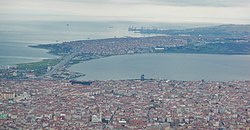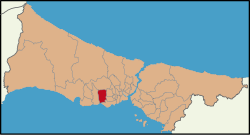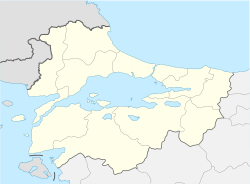Küçükçekmece
Küçükçekmece | |
|---|---|
 Aerial view of Küçükçekmece | |
 | |
 Küçükçekmece | |
| Coordinates: 41°0′N 28°48′E / 41.000°N 28.800°ECoordinates: 41°0′N 28°48′E / 41.000°N 28.800°E | |
| Country | Turkey |
| Province | İstanbul |
| Government | |
| • Mayor | Kemal Çebi (CHP) |
| • Kaymakam | Harun Kaya |
| Area | |
| • District | 37.73 km2 (14.57 sq mi) |
| Population (2018)[2] | |
| • District | 770,317 |
| • District density | 20,171/km2 (52,240/sq mi) |
| Website | www.kucukcekmece.bel.tr www.kucukcekmece.gov.tr/ |
Küçükçekmece (pronounced [cyˈtʃyctʃecmedʒe]; from earlier Küçükçökmece "little depression"; ancient Bathonea) is a suburb of Istanbul, Turkey 23 km west of the city, on the European shore of the sea of Marmara.[3]
Location[]
Küçükçekmece lies on the European shore of the Sea of Marmara, on a lagoon named Lake Küçükçekmece. Across the inlet is the district of Avcılar and the campus of Istanbul University. The inlet is connected to the Sea of Marmara by a very narrow channel, therefore, the water has low salinity.
History[]
The lagoon has almost always been controlled the same imperial power in control of Istanbul, as the Via Egnatia (the road from Constantinopolis/Istanbul to western Europe) passed by here.
According to the Ottoman General Census of 1881/82-1893, the kaza of Küçükçekmece had a total population of 17.975, consisting of 10.945 Greeks, 5.340 Muslims, 1.396 Armenians, 61 Catholics, 31 Latins, 15 Bulgarians and 187 foreign citizens.[4]
During the Greek and Roman periods the site of Küçükçekmece had also been inhabited. The ruins of this town, which have always remained visible, had been studied extensively in 1930 by the Swiss archeologist Ernest Mamboury,[5] who - basing upon ancient sources - identified the settlement with the town of Regium (Ρήγιον in Greek).[5] In 2009 a new identification has been proposed, this time with the Greek and Roman city of Bathonea.[6][7]
Küçükçekmece today[]
The population of Küçükçekmece is growing, and new schools, supermarkets, shopping centres and other facilities are rapidly being built. A lot of the residential areas are gecekondu neighboorhoods, illegally built quasi-slums typical of old working-class Istanbul. A lot of these are being gradually replaced by large housing projects.
Küçükçekmece, along with Başakşehir, Bağcılar, Gaziosmanpaşa, Esenler, Bayrampaşa, Zeytinburnu, and Fatih, are home to many refugees of Syrian origin.[8]
Geography[]
The settlement lies 20 km west from Istanbul. The district is eight kilometers wide, reaching a small inlet west of Istanbul on the banks of Lake Küçükçekmece. The land here is flat, rising very gently away from the shore, and as such is easily built upon. This has historically encouraged, and indeed still encourages, growth and development in the area.
Places of interest[]
A historic bridge, built by Ottoman architect Sinan, crosses the mouth of the lagoon. The bridge has been restored and is well maintained.
Sports[]
The 1911-founded football club Küçükçekmece S.K. play in the Istanbul First Amateur League.
Transportation[]
The Sirkeci-Halkalı railway line passes through Küçükçekmece district serving the railway stations Küçükçekmece, Soğuksu, Kanarya and Halkalı.
Neighbourhoods[]
Neighbourhoods are Atakent, Atatürk, Beşyol, Cennet, Cumhuriyet, Fatih, Fevzi Çakmak, Gültepe, Halkalı Merkez, İnönü, İstasyon, Kanarya, Kartaltepe, Kemalpaşa, Mehmet Akif, Söğütlüçeşme, Sultanmurat, Tevfikbey, Yarımburgaz, Yenimahalle, Yeşilova.[9]
See also[]
References[]
This article includes a list of general references, but it remains largely unverified because it lacks sufficient corresponding inline citations. (September 2009) |
- ^ http://www.istanbulsaglik.gov.tr/w/anasayfalinkler/pano2014/yuzolcumleri_2014.pdf
- ^ ://kucukcekmece.istanbul/icerikler/kucukcekmece/nufusu/710
- ^ "..::Türkiye İstatistik Kurumu Web sayfalarına Hoş Geldiniz::." www.tuik.gov.tr.
- ^ Kemal Karpat (1985), Ottoman Population, 1830-1914, Demographic and Social Characteristics, The University of Wisconsin Press, p. 138-139
- ^ Jump up to: a b Mamboury, p. 569 (1953)
- ^ "Heritage Key". Archived from the original on 2011-07-27. Retrieved 2011-02-02.
- ^ "Greatest finds of the year". The Independent. January 7, 2010.
- ^ HAYATA DESTEK (31 August 2013). Syrian Refugees in Turkey (PDF) (Report). SUPPORT TO LIFE. pp. 4–5.
- ^ Belediyesi, Küçükçekmece. "MAHALLELER". kucukcekmece.istanbul.
Sources[]
- Mamboury, Ernest (1953). The Tourists' Istanbul. Istanbul: Çituri Biraderler Basımevi.
- Küçükçekmece
- Populated places in Istanbul Province
- Districts of Istanbul Province

